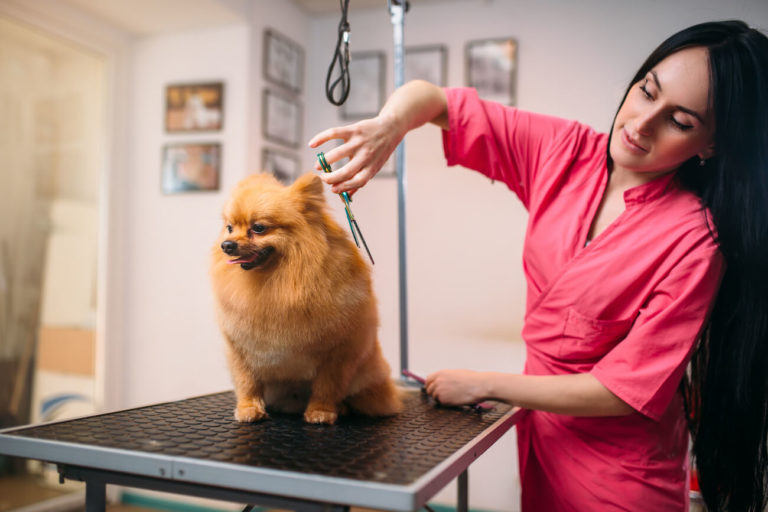How to start a dog walking business: 9 tips to get going

Key takeaways
- If you’re an entrepreneur with a passion for animals, starting a dog walking business could be the perfect choice for you
- Knowing what other dog walkers provide (and don’t provide) can give you a leg up on the competition
- Research and obtain necessary licenses, insurance, and other essentials well before you start taking on clients
If you’re passionate about dogs and want to make some money interacting with them, it might be time to learn how to start a dog walking business.
According to Psychology Today, 78% of pet owners would like their dog to be walked at least twice per day, and nearly all pet owners feel that walks are an important way to help their pet de-stress. But not every dog owner has the time to do this.
Professional dog walkers could be the answer to this problem. Whether you’re looking for a side hustle or a full-time business, discover the key first steps to launching a dog walking company.
How to start a dog walking business

Becoming a professional dog walker is not as simple as telling your friends and family you’re now a dog walker and hitting the pavement with your first pooch. The more work you put in ahead of time, the sooner you can earn money with your dog walking business. Here’s what it takes to launch your new business one step at a time.
1. Get some training
Taking care of your own dog is no substitute for learning more about canine handling. Take an online course or work with a dog training school in your area to learn about general safety for dog walking.
While you don’t always need extensive professional training to open your own business, you’ll feel more comfortable, and more clients will want to work with you. For instance, you’ll want to know basic pet first aid as well as standard training commands. In smaller towns, you might not need a license or specific training to operate a dog-walking business, but that is required in some bigger cities.
If you have friends or family members with professional dog walking experience, you can also interview or shadow them to get their insights and find out what it’s like to walk dogs that aren’t your own.
2. Write a business plan
Writing a business plan is one of the best ways to provide clarity on your new business idea. A business plan outlines everything from your company description and value proposition (i.e., what unique advantage you offer potential clients) to a breakdown of your services, marketing strategies, financial outlook, and goals. It will also help give potential lenders a clear idea about your business if you are seeking funding.
Many of the steps in this guide will help inform the research you do to create a business plan and provide structure when learning how to start a dog walking business.
3. Research competitors
The more you learn about your pet care target market and other dog walking providers in your area, the more informed and prepared you’ll be. Whether it’s an app, an individual, a vet hospital, or a boarding business, research other pet sitting providers and dog walking services in your area. Not only will you learn a lot about the demand for these services, but you’ll also get a sense of basic rates and policies.
You can discover what your competition is doing well and where you have a chance to break in. For example, imagine that other dog walkers are available on weekday mornings only. By offering flexibility in your scheduling, you can close the gap with potential new clients who need evening or midday coverage.
4. Determine your services, policies, and terms
When you launch, you might only offer daily dog walks. Over time, you might add in other services like pet sitting or giving medications to animals at your discretion.
As a business owner, you should also determine:
- Your rates; will you charge a flat fee per walk or will it be based on the duration of the walk?
- The neighborhoods or ZIP codes you will work in
- Whether you require a weekly minimum of walks booked for someone to become a client
There are many choices ahead for your dog walking company, but your services should always be at the core of your decision-making process. This includes creating a standard dog walking contract for your clients. The contract should cover how often you’ll walk the dog, payment amounts, whether the dog is walked solo or as part of a bigger group, and how you’ll address behavior issues on the walks.
5. Select a business name
Choosing a business name that stands out is important. You can use any name you want, so long as it hasn’t been taken by someone else or trademarked. Brainstorm word associations for your own name or pet-related terms, or use a free business name generator like Namelix to get the creative juices flowing.
Once you’ve decided on a name, consider purchasing a domain name (i.e., website address) to market your dog walking business. The company name also opens the door to getting a business bank account for your own dog walking venture.
6. Choose a business structure
Most independent dog walkers operate as a sole proprietorship. This means they are one-person companies. Even so, consider using a fictitious name or a “doing business as” (DBA) name when you register with your county clerk. You could also register as an LLC to give you an additional layer of personal protection. Talk to a business lawyer if you have questions about which structure is right for you.
7. Obtain appropriate business licenses and insurance
Find out if your state and local area require a business license, and fill out this paperwork with your company name. Check out the Small Business Administration site to determine your state license requirements. You should also look into getting business insurance. The most general form of dog walking insurance is liability insurance to protect yourself in the event of an accident.
8. Get a federal and state tax ID number
You don’t need a federal license to open a dog walking business, but you should register as a business. In doing so, you’ll secure your federal and state tax ID number so that you can file your taxes properly.
Even if you’re working solo, you might need to provide a W-9 to any third parties you work with, like a dog walking app. Getting an employer identification number (EIN) means you don’t have to list your Social Security number on these forms.
9. Pick your business tools
Software, systems, and apps are all necessary to keep things straight when you’re your own boss. From booking to cancellations, invoicing, and accounting, set yourself up for success with the basics. You want tools that are easy not just for you but also for your clients.
Consider an app or accounting software for:
- Accepting digital payments
- Booking or rescheduling needs
- Chatting with clients about special instructions
- Accounting to track your income
- Tracking for mileage expenses if you drive to your client’s homes
You’ll also want to provide instructions to clients upfront so they can effectively use the technologies you’ve invested in.
How to market your dog walking business

Getting the word out to family and friends first is a good idea, but you’ll want to expand your reach. From hanging flyers on dog park bulletin boards or in coffee shops to creating a website, plenty of marketing options work well for dog walkers.
Here are some inexpensive ways you can market your dog walking services and increase word of mouth:
- Get business cards to share with local shelters and veterinary clinics or animal hospitals
- Create a website and follow small business SEO best practices to increase traffic
- Claim your Yelp Business Page to provide your business details, upload photos, and increase your chances of appearing when potential clients search for dog walkers in your area
- Create and update social media profiles with your business name and contact information
- Look for non-competitive referral partners, such as pet stores, vets, groomers, and pet sitters
Even though funds might be limited as a startup dog walking business, set a marketing budget. These funds can cover additional local marketing needs, such as placing an ad in the local newspaper or using Yelp Ads.
It’s time for a walk!
If you have an entrepreneurial spirit and a soft spot for dogs, starting a dog walking business can be an ideal venture. As with any small business, it requires a great deal of research and follow-through to make it happen.
With the right business plan, technologies, and marketing, your business will be off to a running start. Then, check out these nine simple tactics to promote your business locally.
The information above is provided for educational and informational purposes only. It is not intended to be a substitute for professional advice and may not be suitable for your circumstances. Unless stated otherwise, references to third-party links, services, or products do not constitute endorsement by Yelp.



